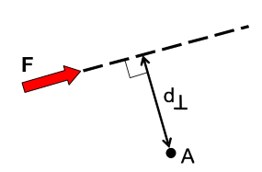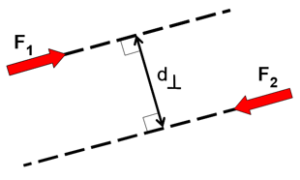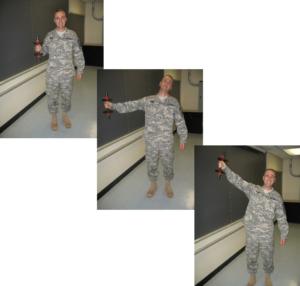Model Description
Introduce the concept of Moment and couples to your students by providing hands-on examples that they can relate to. Demonstrate how levers use the concept of moment to provide a mechanical advantage. This demonstration should take 5-10 minutes.
Engineering Principle
The Moment caused by a force about any point is defined by the equation below.
where Perpendicular distance from the Force’s Line of Action to the point

A couple is defined as two forces, equal in magnitude, with parallel lines of action, but opposite in direction. The Moment caused by a couple is defined by the same equation, with the exception that the distance is defined differently and the Moment caused by a couple is a free vector that can be applied anywhere on the body.
where Perpendicular distance from the Force’s Line of Action to the point

What You Need
| Item | Quantity | Description/Clarification |
|---|---|---|
| Tape Measure | 1 | Any tape measure will do, but it must be long enough to measure the distance from a student’s shoulder to their arm. $5 |
| Barbell | 1 | A barbell (or any object) of known weight. $10-20 |
| Scale | 1 | A typical bathroom scale will do, try to remain consistent in systems of units with the barbell weight and tape measure. $15 |
How It’s Done
In Class: A force’s tendency to cause rotation is a scalar or vector quantity related to two things. Introduce what two things they are by asking a student to come up to the front of the classroom (try to choose a student that is fairly athletic). Tell them that the class will calculate the moment caused by a textbook (or some object lighter than the barbell) about the students shoulder. Give the student the book and ask them which causes greater rotation about their shoulder, holding it close to their body, or holding it far away. The students will answer correctly. Then add the first part of the equation defining moment on the board (d⊥). (You can also show why the perpendicular distance is the important dimension here). Then, ask the same student whether they would like to hold the book far away or the barbell and give them the barbell and ask them to hold it out. The students will answer correctly, then add the second part of the moment equation to the board (F). Next, measure the student’s arm length from the shoulder with the tape measure and calculate the moment on the spot. (Make sure to have the student continue to hold the weight while doing so.)

Additional Application: Demonstrate how Levers use the concept of Moment to their advantage. You can put the Archimedes quote “GIVE ME A PLACE TO STAND AND I WILL MOVE THE EARTH” on the board and ask for students to guess who said it. Then, proceed into different types of levers that are seen in everyday life and how they have defined a way to determine the weights and forces that make these levers work.
